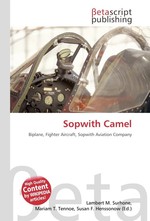Sopwith Camel
Lambert M. Surhone, Mariam T. Tennoe, Susan F. Henssonow
бумажная книга
Please note that the content of this book primarily consists of articles available from Wikipedia or other free sources online. The Sopwith Camel was a British World War I single-seat biplane fighter introduced on the Western Front in 1917. Manufactured by Sopwith Aviation Company, it had a combination of a short-coupled fuselage, heavy, powerful rotary engine and concentrated fire from twin synchronized machine guns. The Camel was credited with shooting down 1,294 enemy aircraft, more than any other Allied fighter in the First World War. Intended as a replacement for the Sopwith Pup, the Camel prototype first flew on 22 December 1916, powered by a 110 hp Clerget 9Z. Known as the "Big Pup" early on in its development, the biplane design was evolutionary more than revolutionary, featuring a box-like fuselage structure, an aluminium engine cowling, plywood-covered panels around the cockpit, and fabric-covered fuselage, wings and tail. Two .303 in (7.7 mm) Vickers machine guns were mounted directly in front of the cockpit, firing forward through the propeller disc with synchronisation gear.
Данное издание не является оригинальным. Книга печатается по технологии принт-он-деманд после получения заказа.


